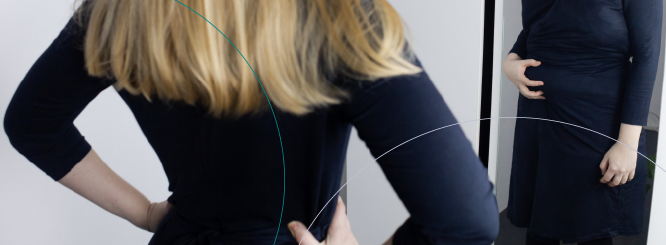
Specialists consider appearance concerns normal at a certain point[1], but what about when you stare at the mirror and start focusing on one specific part of the body, worrying about how it looks? That could only be one sign, but it requires identifying more symptoms to call it a body dysmorphic disorder.
Body dysmorphic disorder (BDD) is a mental health condition in which an individual is excessively preoccupied with perceived flaws in their appearance that are either minor or entirely imagined[2]. The disorder affects both men and women and can develop at any age, although it often begins in adolescence.
The exact cause of body dysmorphic disorder (BDD) is not fully understood yet, but researchers believe that a combination of biological, psychological, and environmental factors may contribute to its development. Patients from all different backgrounds arrive at LIMARP® because they’re looking to improve their quality of life and embark on a healthier path. Our multidisciplinary team, led by Dr. Liza María Pompa González, offers different health services to help you reach your weight goals and beat obesity: from diet and exercise plans, to psychological guidance and surgical intervention.
Biological Factors
Some studies suggest that there may be genetic and neurobiological factors involved in the development of BDD. For example, research has found that individuals with BDD have different brain structures and functions than those without the disorder. Specifically, they have heightened activity in the amygdala, responsible for processing emotions. In fact, there may be a genetic component to the disorder, as BDD appears to run in families.
Psychological Factors
Individuals with body dysmorphic disorder may have low self-esteem, perfectionistic tendencies, and distorted beliefs[3] about their appearance. They may also give too much importance or are sensitive to social feedback and may use their appearance to cope with stress and anxiety. In addition, a history of trauma or abuse may increase the risk of developing this disorder.
External Factors and Social Media
External factors, such as society’s pressure to fulfill unrealistic beauty standards may also contribute to developing body dysmorphic disorder. The media’s portrayal of the ideal body as thin, muscular, and flawless can create a sense of dissatisfaction in individuals who do not meet these standards. Which can in turn lead to the development of body dysmorphic disorder[4].
Additionally, social media and the internet may contribute to the development of BDD by providing individuals with constant exposure to images of “perfect” bodies and faces. Individuals with BDD may spend hours each day obsessing over their appearance, taking and retaking selfies, or checking their appearance in mirrors or other reflective surfaces[5].
Here are some ways in which social media may influence individuals with BDD:
- Exposure to unrealistic beauty standards: This can contribute to feelings of inadequacy, shame, and anxiety.
- Social media: Pictures on platforms, such as Instagram, Facebook, and Snapchat, are often heavily edited and filtered, and they create an unrealistic standard of beauty that many individuals feel preoccupied and pressured to live up to[6]. This pressure can be especially harmful to people who are already vulnerable to developing body dysmorphic disorder.
Despite the negative effects of social media with this condition, there are also positive actions. Social media can provide a platform for individuals with body dysmorphic disorder to connect with others who are going through similar experiences. This can be helpful for individuals who feel isolated or ashamed of their disorder.
Furthermore, mental health professionals can use social media to provide information about it and to promote awareness of body dysmorphic disorder. Social media campaigns that promote body positivity and self-acceptance can also help reduce the pressure to conform to unrealistic beauty standards.
What Are The Body Dysmorphic Symptoms?
As we mentioned, the main symptom of body dysmorphic disorder is an obsessive focus on one or more perceived flaws in appearance. These perceived flaws may be minor or entirely imagined, and they may relate to any aspect of the body, including the skin, hair, nose, eyes, chin, and body shape[7]. Common concerns include acne, scars, wrinkles, blemishes, facial asymmetry, and body size. People with dysmorphic disorder may spend several hours a day obsessing over their perceived flaws, checking their appearance in mirrors, and seeking reassurance from others that they look okay.
Other psychological symptoms of body dysmorphic disorder include anxiety, depression, and social isolation. They might avoid social situations, work, or school due to their perceived flaws, and they may experience significant distress and impairment in daily functioning. Other symptoms include compulsive behaviors such as skin picking, excessive grooming, and seeking cosmetic procedures to try to fix their perceived flaws. These behaviors can affect the individual’s finances and financial stress.
Body Dysmorphic Disorder Diagnosis
Diagnosing body dysmorphic disorder can be challenging because many of the symptoms relate with other mental health conditions, such as obsessive-compulsive disorder (OCD)[8], social anxiety disorder, and major depressive disorder. To diagnose body dysmorphic disorder, a mental health professional will typically conduct a comprehensive psychological evaluation, including a detailed history of the individual’s symptoms, a physical examination, and a psychiatric assessment. The diagnostic criteria for BDD as outlined in the DSM-5[9] are:
- Preoccupation with one or more perceived defects or flaws in physical appearance that are not observable or appear only slight to others.
- At some point during the course of the disorder, the individual has performed repetitive behaviors or mental acts in response to the appearance concerns.
- The preoccupation causes clinically significant distress or impairment in social, occupational, or other areas of functioning.
- If the appearance preoccupations focus on being too fat or weighing too much, the clinician must determine that these concerns are not better explained by an eating disorder. If the patient’s only appearance concern focuses on excessive fat or weight, and the patient’s symptoms meet diagnostic criteria for an eating disorder, then he or she should be diagnosed with an eating disorder, not BDD. However, if diagnostic criteria for an eating disorder are not met, then BDD can be diagnosed, as concerns with fat or weight in a person of normal weight can be a symptom of BDD. It is not uncommon for patients to have both an eating disorder and BDD[10].
- The appearance preoccupation is not better explained by concerns with body fat or weight in an individual whose symptoms meet diagnostic criteria for an eating disorder.
Body Dysmorphic Treatment
Treatment for body dysmorphic disorder typically involves a combination of psychotherapy, medication, and support from family and friends. The specific treatment plan will depend on the individual’s symptoms and the severity of the disorder.
Psychotherapy
Cognitive-behavioral therapy (CBT) is the most effective form of psychotherapy for treating body dysmorphic disorder. CBT helps individuals with BDD identify and challenge their negative thoughts and beliefs about their appearance. The therapist may use exposure and response prevention (ERP) techniques to help individuals confront their fears and compulsive behaviors in a safe and controlled environment.
Cognitive Therapy
Another type of psychotherapy that has been shown to be effective for BDD is mindfulness-based cognitive therapy[11] (MBCT). This approach combines CBT with mindfulness techniques to help individuals with BDD develop more self-compassion and acceptance of their appearance.
Medication
Antidepressant medication, specifically selective serotonin reuptake inhibitors (SSRIs), has been shown to be effective in treating body dysmorphic disorder. SSRIs can help reduce obsessive thoughts and compulsive behaviors, as well as alleviate symptoms of anxiety and depression. However, medication should always be used with psychotherapy and under the supervision of a qualified mental health professional.
Support From Family and Friends
A strong support network can benefit individuals with body dysmorphic disorder. Family and friends can provide emotional support and encouragement. They can also help individuals with BDD seek treatment and maintain a healthy lifestyle.
Body Dysmorphic Disorder Statistics and Facts
- Gender: BDD affects both males and females, but the gender distribution varies depending on the population studied. Some studies suggest that BDD is more common in males, while others suggest that it is more common in females.
- Age of onset: BDD typically develops in adolescence or early adulthood, with the average age of onset being 16-17 years old.
- Comorbidity: BDD often co-occurs with other mental health conditions, such as depression, anxiety, and OCD. Additionally, individuals with BDD are at an increased risk of developing substance use disorders and suicidal ideation.
- Impact on quality of life: BDD can significantly impact an individual’s quality of life. Research has shown that individuals with BDD experience high levels of distress, impaired social and occupational functioning, and reduced quality of life.
Body dysmorphic disorder is a challenging mental health condition that can impact an individual’s quality of life. However, with the right treatment and support, individuals with BDD can learn to live fulfilling lives. If you are struggling with body dysmorphic disorder, seeking help from a qualified mental health professional is necessary.
Body dysmorphic disorder (BDD) has been a concern for mental health professionals for decades, but the rise of social media has added a new layer of complexity to this issue. Social media platforms (Instagram, Facebook, and TikTok), external factors like modern society, biological changes, and mental illness contribute to feelings of inadequacy and body dissatisfaction in individuals with BDD.
Contact Us to Learn More
If you or someone you know has body dysmorphic disorder, do not hesitate to contact us, or schedule an appointment with one of our doctors. We can help determine the right treatment for you. Contact us online anytime or give us a call at (619) 373-0229.
References:
[1, 5] “What is BDD (Body Dysmorphic Disorder)?”. https://bdd.iocdf.org/about-bdd/. (Accessed April 22, 2023).
[2, 3, 7] “Body dysmorphic disorder”. https://www.mayoclinic.org/diseases-conditions/body-dysmorphic-disorder/symptoms-causes/syc-20353938. (Accessed April 22, 2023).
[4, 6] Laughter MR, Anderson JB, Maymone MBC, Kroumpouzos G. Psychology of aesthetics: Beauty, social media, and body dysmorphic disorder. Clin Dermatol. 2023 Mar 5:S0738-081X(23)00029-9. doi: 10.1016/j.clindermatol.2023.03.002. Epub ahead of print. PMID: 36882132.
[8] Phillips KA, Pinto A, Menard W, Eisen JL, Mancebo M, Rasmussen SA. Obsessive-compulsive disorder versus body dysmorphic disorder: a comparison study of two possibly related disorders. Depress Anxiety. 2007;24(6):399-409. doi: 10.1002/da.20232. PMID: 17041935; PMCID: PMC2092450.
[9] “04. Body Dysmorphic Disorder: DSM-5 Criteria and Clinical Features”. https://psychopharmacologyinstitute.com/section/body-dysmorphic-disorder-dsm-5-criteria-and-clinical-features-2576-4961. (Accessed April 22, 2023).
[10] “Diagnosing BDD”. https://bdd.iocdf.org/professionals/diagnosis/. (Accessed April 22, 2023).
[11] “Body dysmorphic disorder (BDD)”. https://www.nhs.uk/mental-health/conditions/body-dysmorphia/. (Accessed April 22, 2023).


